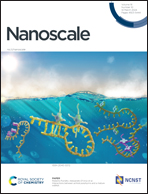Understanding the nanoscale adhesion forces between the fungal pathogen Candida albicans and antimicrobial zinc-based layered double hydroxides using single-cell and single-particle force spectroscopy
Abstract
Antifungal resistance has become a very serious concern, and Candida albicans is considered one of the most opportunistic fungal pathogens responsible for several human infections. In this context, the use of new antifungal agents such as zinc-based layered double hydroxides to fight such fungal pathogens is considered one possible means to help limit the problem of antifungal resistance. In this study, we show that ZnAl LDH nanoparticles exhibit remarkable antifungal properties against C. albicans and cause serious cell wall damage, as revealed by growth tests and atomic force microscopy (AFM) imaging. To further link the antifungal activity of ZnAl LDHs to their adhesive behaviors toward C. albicans cells, AFM-based single-cell spectroscopy and single-particle force spectroscopy were used to probe the nanoscale adhesive interactions. The force spectroscopy analysis revealed that antimicrobial ZnAl LDHs exhibit specific surface interactions with C. albicans cells, demonstrating remarkable force magnitudes and adhesion frequencies in comparison with non-antifungal negative controls, e.g., Al-coated substrates and MgAl LDHs, which showed limited interactions with C. albicans cells. Force signatures suggest that such adhesive interactions may be attributed to the presence of agglutinin-like sequence (Als) adhesive proteins at the cell wall surface of C. albicans cells. Our findings propose the presence of a strong correlation between the antifungal effect provided by ZnAl LDHs and their nanoscale adhesive interactions with C. albicans cells at both the single-cell and single-particle levels. Therefore, ZnAl LDHs could interact with C. albicans fungal pathogens by specific adhesive interactions through which they adhere to fungal cells, leading to their damage and subsequent growth inhibition.



 Please wait while we load your content...
Please wait while we load your content...